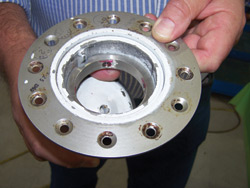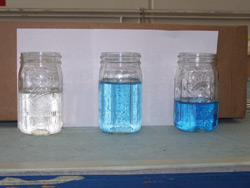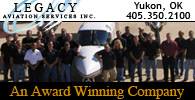Jet A and Piston Commanders
Don�t Go Together

By Jim Metzger

Your airplane should have this restrictor installed in
each fuel filler. However, note that this restrictor
is improperly installed at the bottom of the filler.
This story has been repeated far too often in �Commanderland.� It happened to one of the only Grand Renaissance Shrikes. It happened to a major freight operator in Kansas City. It even happened to R.A. �Bob� Hoover, and it has just happened again�twice in the last 60 days, in fact�with the total loss of both airplanes but, fortunately, no injuries to the occupants. What is �It?� A piston Commander misfueled with Jet A!
A piston Commander will lose significant power and ultimately destroy the engines with as little as 5 percent Jet A in the fuel system. Ten percent or more will cause a complete loss of power, and quickly. It is time to revisit the extremely important issue of misfueling.

After the aforementioned incident with Bob Hoover (which had a somewhat happy ending because there were no serious injuries, but the airplane was a total loss), Airworthiness Directive 87-21-07 was issued by the FAA requiring that all piston Commanders be fitted with a fuel restrictor ring in all fuel filler openings. This simple device is easily installed inside each fuel filler port. The fuel dispensing nozzle that is used to service airplanes with Jet A is too large to be inserted into the restrictor ring, therefore eliminating the chance of misfueling a piston Commander. So why do we still have these accidents?
There are several reasons. First, believe it or not I have recently seen several piston Commanders that do not have the restrictors in place. Hard to imagine that airplanes could have remained in service for over 20 years with this important A.D. not complied with. Is your airplane in compliance? Better check (see photo).
Second, some restrictors have been improperly installed. It is important that the restrictor be placed at the top of the filler opening. The photo shows a restrictor misinstalled at the bottom of the filler neck. This allows a creative line person to insert the larger Jet A nozzle far enough into the filler port to misfuel your piston Commander. Most Jet A trucks have more than enough pressure to open the anti-siphon flap in the tank opening and allow the fuel to enter the tank.
Lastly, there are a few turbine helicopters that have a smaller-than-usual fuel filler opening. This necessitates the use of a reducer on the end of the fuel nozzle. The reducer will allow the line person to very easily misfuel your airplane!
IS YOUR FUEL TRUE BLUE?

So, what should you do? First, make certain proper fuel decals are located next to each fuel-filler opening to identify your airplane as one using only avgas. If yours are worn or missing, Air BP (800-752-9220) will provide new ones at no charge.
Next, make certain that your airplane is equipped with the fuel restrictors mandated by the FAA and that they are properly installed at the top of each filler opening. Then, make sure you are very specific when ordering fuel. Simply asking the line crew to �top it off� will no longer do. You should always state clearly that you need to have the airplane �topped off with one hundred low-lead avgas,� and then make certain the person taking the order gives you a proper �read back.�
You should also check the receipt when you make payment. Avgas and Jet A are priced differently; Jet A is generally less expensive. Be sure you paid for avgas! Lastly, you should make every attempt to be present through the entire refueling process. More importantly, if you have ANY doubt about the type of fuel in your tanks, DO NOT DEPART!
If, despite the safeguards, the worst thing happens and you find yourself at the controls of a misfueled Commander, here is what might happen. It is a myth that a misfueled airplane will not start. There will always be enough uncontaminated fuel in the system to start the engines. In fact, it will take several minutes of ground operation before contaminated fuel will makes its way to the engines.
If you notice that the engines are running a bit rough, are sluggish, or are slow to accelerate, investigate! Remember, this may or may not occur depending on the amount of contamination and the length of time the engines are operated before takeoff.
If it was a quick turn with no need to warm the engines before departing, it is likely the contaminated fuel will not reach the engines until well into the takeoff. The right engine probably will be affected first because the fuel sump, which feeds both engines, is located on the right side of the main fuel tank, and the line delivering fuel to the right engine is several feet shorter.
First you will notice a rough engine. The engine will sound �wrong� as the contaminated fuel causes severe detonation, there will be a pronounced loss of power, and cylinder head temperature will quickly move toward the red line. If your Commander is equipped with long-range fuel and those tanks were not serviced, you may be able to simply switch to those tanks and restore power. However, your engines may have been damaged, so return and land immediately.
If you find yourself with rapidly deteriorating power because of misfueling, there may be one last thing to try that could get you safely back to the airport. One reason jet fuel will not run in a piston engine is the total lack of detonation control. Reducing power reduces that detonation and may keep your engines running long enough to make a difference in the outcome. At best the engines will only make a small percentage of their rated power, but it might be just enough.
At least one Commander made it back safely using this technique. It will take quick thinking and nerves of steel to reduce power on a pair of failing powerplants, but it just might do the trick. Of course, the best trick is to make certain your piston Commander always has the correct fuel!
Jim Metzger is a 15,000-hour Commercial pilot and A&P with Inspection Authorization. He is the Director of the Twin Commander Flight Group (www.aerocommander.com), a club for Commander owners and enthusiasts.
Discuss this article in the forums...








